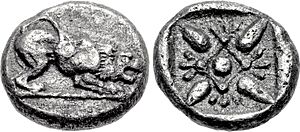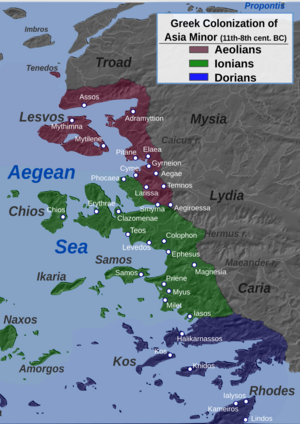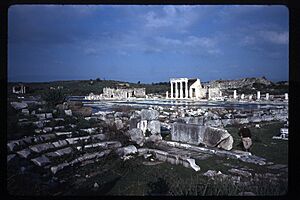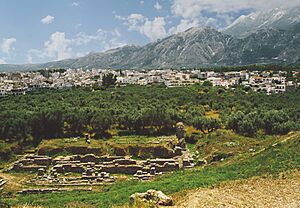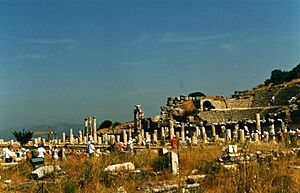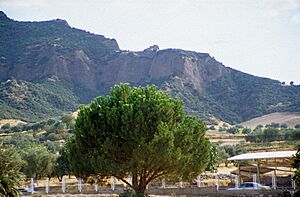Aristagoras facts for kids
Aristagoras of Miletus (Greek: Ἀρισταγόρας ὁ Μιλήσιος) was a leader from the ancient Greek city of Miletus. He lived in the late 500s BC and early 400s BC. He is famous for helping to start the Ionian Revolt. This was a big uprising against the powerful Persian Empire.
Aristagoras was the son-in-law of Histiaeus, who was the previous ruler of Miletus. Histiaeus gave Aristagoras control of the city. The Greeks had lived along the coast of Asia Minor for a long time. But in the late 500s BC, the Persians invaded their lands. The Greek cities, including Miletus, became part of the Persian Empire. The Persians allowed them to rule themselves, as long as they paid taxes. But many Greeks were unhappy with Persian rule.
Aristagoras played a key role in starting the Ionian Revolt. He worked with Histiaeus to plan the rebellion. Many Greek cities in Ionia joined the revolt. However, they did not get enough help from the Greek cities on the mainland. Because of this, the Persians attacked the rebel cities with a huge army. They destroyed many cities, including Miletus. In Miletus, Persian soldiers killed the men. They sold the women and children into slavery. The Persians wanted Miletus to remain empty for a long time.
Before Miletus was destroyed, Aristagoras left with some people. He led them to Thrace, a region north of Greece. He settled in a city called Myrcinus. Later, he tried to capture another Thracian city. During this battle, Aristagoras and his men were killed. Two years after the Ionian Revolt ended, the Persians attacked mainland Greece. This was to punish cities like Athens for helping the Ionian rebels.
Contents
Aristagoras: Early Life and Role
Around 500 BC, Aristagoras was a deputy ruler of Miletus. Miletus was an important polis (city-state) on the western coast of Anatolia. Aristagoras's father, Molpagoras, had also been a ruler of Miletus.
Aristagoras was also the son-in-law of Histiaeus. The Persians had made Histiaeus the ruler of Miletus. But they did not fully trust him. A Persian general named Megabazus complained about Histiaeus to King Darius I of Persia. Darius then called Histiaeus to his court. He kept Histiaeus in Susa, the Persian capital, as an advisor.
Histiaeus suggested that Aristagoras become the new ruler of Miletus. The Persians agreed to this. So, Aristagoras ruled Miletus while Histiaeus stayed in Susa. Histiaeus was kept under watch, away from his troops. Aristagoras became the main leader of the Ionian Revolt. He secretly followed instructions from Histiaeus. Histiaeus wanted to return to Miletus. He hoped Darius would send him back to deal with a rebellion.
| Timeline of Aristagoras | |
|---|---|
| 511 BC | Histiaeus gives his position as ruler of Miletus to his son-in-law, Aristagoras. |
| 502 BC | Naxos rebels against Persia. It asks Aristagoras for help. The attack fails. |
| 499 BC | Histiaeus encourages Aristagoras to rebel. |
| 499 BC | Aristagoras starts a rebellion in Miletus against Persian rule. |
| 498 BC | Aristagoras seeks Greek allies. Cleomenes I of Sparta refuses to help. Athens offers help. |
| 497 BC | With help from Athens, the rebels capture and burn Sardis. Sardis was the capital of the Persian region of Lydia. Miltiades, ruler of the Thracian Chersonese, flees to Athens. |
| 494 BC | The Ionian revolt is stopped by the Persians. Miletus is destroyed. Aristagoras flees to Thrace, but is killed by the Thracians. |
The Failed Attack on Naxos
Some people who had been forced to leave Naxos came to Miletus. They asked Aristagoras for soldiers to help them return home. Aristagoras thought that if he helped them, he could become the ruler of Naxos. So, he agreed to help.
Aristagoras told them he did not have enough soldiers. But he said Artaphernes, King Darius's brother, could help. Artaphernes was the Persian governor of Lydia. He had a large army and navy. The Naxians agreed and gave Aristagoras money.
Aristagoras went to Sardis to meet Artaphernes. He suggested that Artaphernes attack Naxos. He said Naxos was a rich island, close to the Ionian coast. It was also a gateway to other islands the Persians did not control. Aristagoras promised to pay for the attack. He also offered Artaphernes extra money. He said capturing Naxos would help the Persians control other islands. Artaphernes agreed and promised 200 ships.
The next spring, Aristagoras sailed with the fleet. But he argued with the Persian admiral, Megabates. Aristagoras interfered when Megabates was punishing a ship captain. This made Megabates angry. Megabates then secretly warned the Naxians about the attack. This removed the element of surprise.
Naxos had time to prepare for a siege. After four months, the Persians ran out of supplies. The attack failed, and the Persians sailed home.
Starting the Ionian Revolt

Because the Naxos attack failed, Aristagoras was in trouble. He started planning a revolt with the people of Miletus and other Ionian cities. Meanwhile, Histiaeus, still held in Susa, sent a secret message to Aristagoras. The message was tattooed on a slave's shaved head. Once the slave's hair grew back, he was sent to Aristagoras. The message told Aristagoras to rebel. Histiaeus hoped this would make Darius send him back to Miletus.
Both leaders wanted the same thing. So, Aristagoras met with his supporters. They agreed to rebel against Persia in 499 BC. Most citizens supported the revolt. Only the historian Hecataeus of Miletus voted against it. He believed the Ionians would lose. But once the vote was taken, he still helped with suggestions.
As soon as the revolt was decided, Aristagoras took control of nearby Persian ships. He sent people to arrest the Persian admirals. These admirals were mostly Greek. They were later released. Now that the rebellion was open, Aristagoras wanted to harm Darius in every way.
The revolt quickly spread across Ionia. Aristagoras knew one city alone could not defeat the Persians. So, he formed an alliance of all the Ionian cities. He also made some changes to the government. First, he gave up his own power as ruler. Then, he convinced other cities to end their own rulers. Finally, he told all the cities to choose generals to report to him. Once his new government was set up, he sailed to Lacedaemon and other Greek states to find allies.
Aristagoras wanted the people to join the revolt. He said he would end the rule of single leaders. He would establish "isonomia," which means "equality of government" or "equal rights." He stopped the rule of single leaders in other Ionian cities. He also made them choose groups of generals to report to him. It seemed a new independent Ionia was formed, with Aristagoras as its head. This new state could collect taxes and raise armies. Aristagoras was the commander of the combined forces. Miletus was to be the new capital.
Sparta Refuses to Help
In 499 BCE, Aristagoras asked the Spartan king, Cleomenes I, for military help. He praised Spartan warriors. He argued that attacking Persia first would be easy. To show his point, he brought a bronze map of the world. Some scholars think this map might have come from Hecataeus of Miletus or Anaximander of Miletus.
Aristagoras claimed the Persians would be easy to defeat. He also tried to tempt Cleomenes with promises of Persian riches. Cleomenes asked for two days to think. When they met again, Cleomenes asked how long it would take to reach Susa. When he learned it was a three-month journey, he refused help. He said his troops would be away too long. Sparta was also worried about attacks from its rival, Argos. The Greek historian Herodotus said Aristagoras tried to bribe Cleomenes. But the king's young daughter, Gorgo, warned her father. She said Aristagoras would corrupt him. Aristagoras left without Spartan help.
Athens Joins and Then Leaves
Aristagoras then went to Athens. He gave a convincing speech, promising everything he could think of. Finally, he succeeded. The Athenians agreed to send ships to Ionia. Aristagoras went ahead of them. The Athenians arrived in Miletus with twenty warships. Five more ships came from Eretria. Herodotus said these ships marked the start of big troubles between Greeks and Persians.
Once all his allies arrived, Aristagoras put his brother Charopinus and another Milesian, Hermophantus, in charge. The whole group set out for Sardis, the capital of the region. Aristagoras stayed in Miletus to govern.
First, they sailed along the coast to Ephesus. From there, they marched overland to Sardis. They surprised the city's defenders. The governor Artaphernes and his forces quickly retreated to the city's high fortress (acropolis). A fire started by accident in the city. It burned down the temple of the Lydian goddess Cybebe (Cybele). The Persians later used this fire as an excuse to burn Greek temples.
The fire forced the defenders to leave the acropolis. They moved to the marketplace. At the same time, Persian reinforcements arrived. The Ionians thought this was a counter-attack. They retreated to Tmolus, a nearby hill. From there, they escaped by night. The Persian reinforcements followed them. They caught up near Ephesus and defeated the Ionians.
The Persians had conquered Lydia, including all the Greek cities there. They showed mercy to win over the local people. News of the attack spread quickly. Combined Persian and local forces rushed to help the governor.
Their quick arrival surprised the Ionian and Athenian forces. The Persians had strong cavalry. They easily tracked and caught the Ionians near Ephesus. The mainland Greeks suffered heavy losses. They decided to return home, leaving Aristagoras and the rebels to fight alone. The revolt seemed doomed. But the Ionians fought bravely. The rebellion spread to nearby Greek islands.
After this battle, the Athenians refused to keep fighting. They returned to Athens. However, because Athens helped the revolt, King Darius swore revenge. He ordered a servant to remind him three times a day: "Master, remember the Athenians." This story might be true. The Persians had already planned to expand into the Balkans.
The Ionians continued to fight. They gained control of Byzantium and nearby towns. They also controlled most of Caria. Almost all of Cyprus also rebelled against the Persians. Onesilus, the younger brother of Gorgus, the ruler of Salamis, convinced the Cypriots to revolt. They then attacked the city of Amathus.
The End of the Revolt
Before the revolt completely failed, Aristagoras looked for a safe place to go. He and his men decided on Myrcinus in Thrace. This had been an Ionian stronghold during a previous Persian invasion. He put Pythagoras in charge of Miletus. Then, he sailed to Thrace. He tried to start a new Greek settlement there. This was at the same place where Athens later built Amphipolis.
The Thracians did not want more Greeks in their country. They fought against this new settlement. Aristagoras gained control of the area. But later, while attacking a nearby town, Aristagoras was killed in battle.
Aristagoras had hoped to create a safe place for Ionians. He thought they could later help Miletus. But his actions led to him being called a coward by the historian Herodotus. Herodotus blamed Aristagoras's flight for the revolt's defeat. However, the revolt actually grew stronger and spread to the islands after he left. Aristagoras could not have known this.
In the final months of the revolt, the Persians recaptured rebel cities one by one. When almost all was lost, King Darius was convinced by Histiaeus. Histiaeus said he could end the conflict. He asked to be sent back to Miletus.
Histiaeus never reached Miletus. He first went to Sardis. He was questioned about his loyalty. Histiaeus swore he knew nothing about the revolt. He claimed to be completely loyal to the Persians. But the governor, Artaphernes, was not fooled. He told Histiaeus, "I will tell you how it is: this shoe is of your making; Aristagoras has only put it on."
Histiaeus realized he was in danger. He escaped that night and sailed away. He found troops and ships. But the Ionians did not trust him. Miletus would not let him return. He became a mercenary (a soldier for hire) in the Aegean Sea. Eventually, Artaphernes hunted him down and executed him. The Ionian Revolt finally ended in 494/493 BC. The Persians then prepared to invade Greece. This was to punish Athens for its role in the revolt.
The Ionian Revolt failed because the Greeks had fewer resources. Also, the mainland Greek states were unwilling to get fully involved. Persia regained control over the Ionian Greeks. After only one year, the Cypriots were also forced to surrender to Persia. Cities around the Hellespont fell to Persian forces. The Carians fought the Persians but were defeated. Cyprus was recaptured by Persian and Phoenician forces.
The revolt was over by 494/493 BC. In 494 BC, the Persians attacked Miletus directly. They defeated the Ionians in a naval battle near Lade, an island off Miletus. The city was then besieged and captured. Miletus was destroyed, and its people were killed or taken away. The Persians were more interested in ruling than in revenge. They began planning for the invasion of Greece. This started in 490 BC and led to the Greco-Persian Wars.
Images for kids


